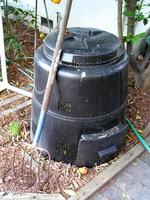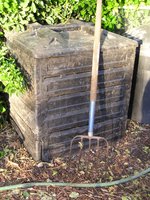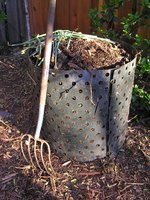Container composting
|
|
Container composting - There are sound reasons for composting in containers, although there is debate as to whether slatted or closed sided bins are preferable, for this will affect air circulation within the compost pile, as well as the potential for heat loss. The Indore method developed by Sir Albert Howard and the Shewell Cooper method favour slats, whilst the New Zealand Box method advocates the use of closed sides. There are also differences between these techniques in terms of activators (that is, high nitrogen content organic substances to stimulate high bacterial activity within the heap, e.g., urine, grass mowings, comfrey leaves, etc.) and materials used. However, most agree that a good mixture of carbon and nitrogenous materials, usually created in layers and on a base consisting of rougher, stemmy material (to encourage air circulation) that is in contact with the soil are essential to all successful composting processes.
Above: Twin vault 'New Zealand Box' compost system.
For those who do not have a lot of space, composting can be carried out with good results by using cylindrical bins provided that attention is paid to the all-important issues of aeration and C:N ratios. Such bins are available proprietarily, and are often supplied by local authorities at low cost to encourage recycling.
An assortment of commercially available compost bins
See also:




